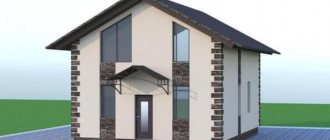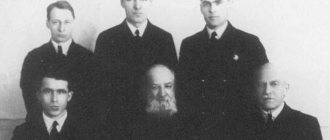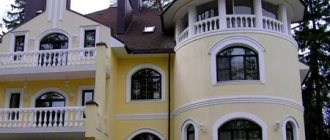For the term "Soviet Union" see also other meanings.
| Type "Soviet Union" | |
| Project | |
| A country |
|
| Main characteristics | |
| Displacement | standard 59,150 t full 65,150 t |
| Length | 269.4 m (260.0 m by vertical line) |
| Width | 38.9 m (36.4 m along the vertical line) |
| Draft | 10.19 m |
| Booking | armor belt: 375-420 mm, bulkheads: 230-365 mm, barbette: 425 mm, gun turrets: 495 mm, deck: 25+155+50 mm, wheelhouse: 425 mm |
| Engines | 6 triangular boilers |
| Power | 201,000 l. With. |
| Travel speed | 29 knots maximum 28 knots cruising |
| Cruising range | 7200 miles |
| Sailing autonomy | 30 days |
| Crew | 1226 sailors, 66 officers |
| Armament | |
| Artillery | 3×3 406.4/50 mm AU B-37 6×2 152 mm |
| Flak | 6×2 100 mm 10×4 37 mm 46-K |
| Aviation group | 4 KOR-2 aircraft, 2 catapults. |
| Media files on Wikimedia Commons | |
Project 23 battleships
(type
"Soviet Union"
) - a project of battleships built for the USSR Navy in the late 1930s - early 1940s as part of the construction program of the "Large Sea and Ocean Fleet". It was believed that the new battleships would be the largest and most powerful in the world. None of the laid down ships of the project could be completed and included in the Soviet fleet.
Content
- 1 Development history 1.1 Decision making to create a new type of ship
- 1.2 Final approval of the project
- 3.1 Hull and superstructure design 3.1.1 Armor
- 3.2.1 Characteristics of the power plant
- 4.1 Artillery weapons
- 7.1 References
Development history
Making a decision to create a new type of ship
The combat regulations of the Red Army Naval Forces - 1930 (BU-30) recognized battleships as the main striking force of the fleet, and the course towards industrialization opened up real prospects for their creation. The technical design of the battleship was completed by the end of April 1937. However, its approval and the laying down of the first two ships ordered on November 22, 1936 to the Baltic Shipyard did not take place. At the end of May 1937, the standard displacement was increased to 55,000 tons, changing the original design.
Final approval of the project
Initially, the completion date for the design work was scheduled for October 15, 1937, but “project 23” was finally approved by a resolution of the Defense Committee of the Council of People's Commissars of the USSR only on July 13, 1939, when the lead ship was already laid down.
The planned cost of the first four ships of the project (1.18 billion rubles[1]) was equal to almost a third of the country's annual naval budget in 1940[2].
Modern project management system in construction
Today, demands in organizing construction processes have changed significantly, as significant changes have occurred in the field of project management. Other forms of management are dictated by the need to optimize and speed up work processes, and new advances have appeared in the world of computing.
Currently, the use of information systems in construction management is necessary. However, the management model has not changed radically. The entire list of events in the workflow has been preserved in its previous form.
The work package in the control infrastructure looks like this:
- Feasibility study of engineering searches for project implementation.
- Creation of design and estimate documentation.
- Preparation for zero cycle work.
- Construction of the object.
- Ensuring quality control.
- Inspection of the building before delivery.
This is interesting!
“Building design: types, stages”
More details
Modern residential building construction systems have become more efficient nowadays. There have been significant changes in the communication system. They are now more reliable due to increased functionality. This is why it is easy to coordinate the individual groups involved in the project.
The general management infrastructure can provide a wide range of technical procedures related to logistics, document circulation, processing of engineering research data, structural calculations, etc. The systems are so powerful that they can perform many operations, and the operator has the ability to generate estimates on various parameters based on analysis.
History of construction
In general, under Project 23, a colossal amount of development work was carried out (more than a hundred models were built) and various tests, including: experimental bombing of a converted dry cargo ship (appropriate deck protection was installed), simulating explosions on mines and torpedoes (more thirty scale and two full-scale). Protection against proximity fuses was created - a demagnetizing device, designed at LPTI in 1936-37 and subsequently used on ships of all classes. In addition, slipways and outfitting and emergency docks were prepared at the Baltic and Nikolaevsky factories. Thus, the process of designing these battleships gave a powerful impetus to the creation of large ships at domestic shipyards.
The lead battleship "Soviet Union", serial number S-299, was laid down in Leningrad at the Baltic Shipyard. This is evidenced by the official report:
“To the Head of the Shipbuilding Department of the RKKF, Flag Officer 3rd Rank Comrade Gorshkov. I hereby inform you that on July 15, 1938, the Soviet Union aircraft was laid down at the S. Ordzhonikidze plant. Military engineer 1st rank authorized by the Criminal Code Kudzi"
In 1938-1939, three more battleships were laid down at two other enterprises: “Soviet Ukraine” (S-352) in Nikolaev, “Soviet Russia” (S-101) and “Soviet Belarus” (S-102) in Molotovsk.
In October 1940, an order was given to suspend the construction of the ship “Soviet Belorussia”, which was 1% complete, and to concentrate the main efforts on the ship “Soviet Union”[3]. Due to the outbreak of the Great Patriotic War, the construction of battleships was stopped (the readiness of the "Soviet Union" was 19.44%, the "Soviet Ukraine" - only 7%), and at the end of the war the unfinished ships were dismantled.
Traditional project management in construction
The process of managing a housing construction project is complex. And if it is well thought out, then the project deadlines and safety will be normal, and the operating time will not cause concern.
There are people who believe that strategic or operational construction planning is too simple. Definitely, they will discover that it is not enough to control, you need to take into account all the features.
Today, it has been proven in practice that a boss who has gone through all stages of development from the very beginning to a high position is the best in his field. Because he knows as much as possible about his work. Therefore, the advantage in organizing construction will be with the company that is well versed in this topic.
It is difficult to ensure logistics during project implementation and the versatility of the work processes produced, therefore an organizational management model in construction is necessary. To achieve the set goals, you need someone who will take the lead and control not only the project participants, but also correctly distribute resources. And the construction management system can handle this.
Having optimized the entire working period at each level, coordination will become the mission of the management structure. It is necessary to be ready at any time to adjust financial costs, reduce the role of factors that can have a negative impact on the entire process, and also adjust tactics for construction and installation work, if necessary.
Design
The unsinkability of the ship was ensured when the unarmored part of the ship was destroyed and two 21-inch torpedoes were simultaneously hit in the bottom or three torpedoes in the boules. Much attention was paid to the quality and strength of connecting armor plates in various ways: with rivets in three rows in a checkerboard pattern, with dowels, etc. The possibility of using welding was considered, which gradually became part of the practice of Soviet and foreign shipbuilding (welded armor decks with a thickness of 12– 30 mm German cruisers of the Admiral Hipper type). Based on the results of a war game held in 1938 at the Naval Academy with training shooting on a training stand, it was believed that Soviet ships of Project 23 would have advantages over foreign battleships. At the same time, the conclusion was made about the “benefit of the 85-105 mm caliber for anti-aircraft artillery,” which subsequently required significant clarification.
Hull and superstructure design
Booking
armor belt: 375—420 mm, belt height 6.27 m, tilt angle 5°,
bulkheads: 230-365 mm,
barbette: 425 mm,
gun turrets: 495 mm,
deck: 25+155+50 mm,
deckhouse: 425 mm
Anti-torpedo protection
Anti-torpedo protection was designed for a charge explosion of up to 750 kg of TNT equivalent. The anti-torpedo protection had a length of slightly less than 70% of the ship’s length along the vertical line. Over most of its length, its depth was at least 7.5 m (at the midships - 8.2 m) and only at the bow traverse of the citadel (the 64th frame) it decreased to 7.1 m. In the aft part of the citadel, for design reasons, instead The Italian system was used in favor of the American one with four longitudinal bulkheads. For an objective comparative assessment of various protection systems, in 1937-1938 a series of experiments was carried out in Nikolaev with the detonation of 24 large-scale (1:5) compartments manufactured by Plant No. 200 of seven systems known at that time. The results of these tests, carried out by the commission of Captain 2nd Rank Lundyshev, selected the two most effective ones: the American one, used on the battleship West Virginia, and the Italian Pugliese-Littorio class. Based on these results, in February 1938 they proposed replacing the Italian system with an American one on the Project 23 ship, considering it more preferable, both in terms of explosion resistance and design and operational qualities. The proposal was rejected due to fears that the rework would delay the ship's laying date.
Power plant
The ship's power plant included three main turbo-gear units (GTZA) with a capacity of 67,000 hp each. With. (maximum 77,000 hp) and six water-tube boilers.
Characteristics of the power plant
The steam output of one boiler is 162 t/h (maximum 185 t/h), outlet pressure 37 atm. at a temperature of 380. The GTZ of the battleship was unified with the units of the Project 69 heavy cruiser.
Su-27KM project. Forward sweep for an aircraft carrier
Scheme of the S-22 fighter, mid-80s. Drawing by Paralay.com
At one time, the experimental Su-47 Berkut aircraft became widely known. It was distinguished from other equipment by its unusual architecture with a forward-swept wing (SWS). The Sukhoi Design Bureau began studying the topic of CBS in the early eighties and even developed several projects using such a wing. The immediate predecessor of the experimental Su-47 in this context was the Su-27KM project, which proposed a carrier-based fighter with an unusual aerodynamic design.
First developments
At the turn of the seventies and eighties, our country launched a program to create a promising fighter to renew the Air Force fleet in the nineties.
Work on this topic was transferred to the Mikoyan Design Bureau, and the bureau to them. BY. Sukhoi was assigned to make other aircraft. At the beginning of 1983, M.P. became the general designer of the Sukhoi Design Bureau. Simonov. Almost immediately, he proposed to begin the proactive development of a promising fighter - without an order from the military. “For camouflage,” the project was given the working code S-22, which could be confused with the name of one of the production aircraft. V.S. was appointed chief designer. Konokhova.
At that time, Simonov and his colleagues showed great interest in WWTP. Research has shown that such a wing has significant advantages over a “regular” one, although it is more difficult to manufacture. In a number of characteristics, a fighter with CBS could be superior to the technology of the normal design.
Model of the S-32 aircraft. Photo: Testpilot.ru
As part of the S-22 project, we carried out the necessary research and prepared a complete set of working documentation. It was proposed to build a canard-type aircraft with a front horizontal tail and a CBS. The car was equipped with one engine; there was a single cabin. Take-off weight reached 22-24 tons, incl. several tons of combat load.
Project S.32
At the final design stage, it turned out that the S-22 was overly heavy.
Correcting these shortcomings required a radical redesign of the project. In this regard, work on the S-22 was stopped, and the accumulated experience was used as the basis for a new project - the S.32. Now the creation of a twin-engine aircraft with increased thrust-to-weight ratio was considered. It was proposed to preserve CBS with all its advantages, as well as use some ideas in the field of reducing radar signature. Designers led by M.A. Pogosyan considered several options for the layout and equipment of the aircraft, after which they chose the optimal one.
The S.32 airframe was generally similar to the previously developed one. The canard design received an additional rear rotating stabilizer. Above it was a pair of keels. The forward-swept wing has been preserved. The power plant now consisted of two R-79M engines or a pair of AL-41F engines under development with thrust vector control. In the latter case, it was possible to reach supersonic speed without afterburner. UVT and CBS were supposed to provide unique maneuverability.
Su-27KM in flight. Drawing Popmech.ru
Modern instrumentation of the cockpit was provided, ensuring the unloading of the pilot and the solution of all basic tasks. NPO Zvezda proposed an original ejection seat of variable geometry, which reduces the impact of overload on the pilot.
"Ship, modernized"
Initially, the S.32 was considered as a land-based aircraft.
However, by the mid-eighties, the Ministry of Defense began to show increased interest in carrier-based aircraft. OKB im. Sukhoi reacted to this with a corresponding initiative - the development of a carrier-based modification of the S.32 fighter. In 1988, a preliminary design of the promising Su-27KM fighter (“Ship, modernized”) was prepared. It was based on the S.32 project, but was positioned differently. In order not to confuse the customer with excessive novelty, it was presented as a deep modernization of the existing Su-27K (future Su-33).
The main provisions of the Su-27KM project remained the same. A glider of the “longitudinal triplane” type was proposed with a forward-swept wing, two engine compartments in the tail, etc. At the same time, measures were taken to strengthen some of the units that experience certain loads during operation on an aircraft-carrying ship. The instrumentation has been redesigned.
A fighter variant with folding wings. Drawing Popmech.ru
It was proposed to build an improved airframe from metal and composites. Metal parts were used in the power set and partly in the casing. The loaded part of the wing skin was composite. This made it possible to ensure the required structural strength, but made it difficult to place the wing folding mechanism. It had to be outside the projections of the composite parts so that they could distribute the loads in the correct way.
We have developed two methods for reducing the size of the aircraft for more dense placement in the hangar. In the first case, the folding hinges were placed in the center section and did not affect the composite part of the wing. The planes were supposed to fold up and forward and lay on the fuselage.
The second option did not use wing hinges. Instead, side-folding keels were used. Aircraft of this design, having a minimum height, could be stored on special racks in several tiers.
A power plant with two R-79M engines with UVT was transferred to the “ship” project. The possibility of outputting two jet streams through a common flat nozzle with control in the vertical plane was considered.
A flying laboratory based on the Su-27 for testing a flat nozzle. A similar unit could be used on the Su-27KM. Photo Airbase.ru
The Su-27KM project provided for the use of advanced on-board electronic equipment and weapons control systems. The aircraft was supposed to conduct dogfights or attack ground/surface targets. The weapon was planned to be carried on an external sling and in an internal compartment.
The promising aircraft was similar in size to existing models, and the maximum take-off weight reached 40 tons. With such a mass, the aircraft needed a launch catapult, but such units were not available at that time. An alternative was the so-called. ballistic takeoff from a springboard, which could only be provided by a forward-swept wing.
During a ballistic take-off, the aircraft, passing the cut of the springboard, has insufficient lifting force. By inertia, it gains a small altitude, but then drops by 10-15 m. Reaching the bottom point of this decline, the aircraft develops the required speed, and the CBS gains lift. After this, the car can confidently stay in the air and fly.
Customer solution
The preliminary design of the Su-27KM aircraft was prepared in 1988 and immediately received customer support. The research work received the necessary funding, and construction of a flight prototype was expected in the foreseeable future. However, this did not happen.
Experimental aircraft Su-47 "Berkut". Photo Airwar.ru
In May 1989, the Military-Industrial Commission under the USSR Council of Ministers decided to close a number of promising projects in all major areas. Along with other projects, the Su-27KM was cut. Work on the aircraft in the interests of the navy ceased. According to some reports, the Su-27KM project was closed in favor of creating the future two-seat Su-27KUB.
The Su-27KM project was canceled at fairly early stages, and construction of the prototype did not begin. Moreover, by May 1989, they had not even managed to build and test the necessary flying laboratories. Similar work was carried out later as part of another project.
From project to experiments
OKB im.
Sukhoi was forced to stop creating a carrier-based fighter with CBS. However, it did not abandon the promising direction as a whole. Work on the forward-swept wing continued - again in the context of land-based aviation. Already in 1989, work on the topic C.32 was continued on an initiative basis. This project was reworked taking into account the experience of developing the Su-27KM. New solutions, components and technologies have been introduced into it. At the same time, we had to abandon some overly bold and expensive decisions. At this stage, flying laboratories with one or another equipment were tested.
Carrier-based fighter Su-33. Due to the failure of the Su-27KM project, it did not receive a replacement. Photo by the Russian Ministry of Defense
Soon a new version of the S.32 project appeared, which received its own designation S-37. In 1997, an experimental aircraft of a characteristic appearance was built based on this project, and two years later a machine named “Berkut” was first shown to the general public. Subsequently, this experimental aircraft was involved in various studies, incl. during the development of a fifth generation fighter.
Predecessor and successors
Thus, the carrier-based fighter with a forward-swept wing, the Su-27KM, remained on paper, although it had a chance of reaching at least flight tests.
However, the developments on this project were not lost, they were implemented and tested in practice. Subsequently, the experimental project S-37 / Su-47, which partially replicated the Su-27KM, contributed to the emergence of a new generation of domestic fighters. However, the most interesting design solutions of the S-22, S.32, Su-27KM and Su-47 projects never reached series production and operation among the troops. The newest and most advanced Su-57 received a traditional swept wing.
Armament
Artillery weapons
The artillery armament of the battleships was to consist of nine 406-mm main-caliber guns in three turrets, twelve 152-mm guns in six two-gun turrets, as well as eight 100-mm anti-aircraft guns in four twin turrets and thirty-two 37-mm anti-aircraft guns in quadruple turrets. nest installations.
The 406-mm B-37 naval gun was specially developed for battleships. Due to the cessation of the construction of battleships of the "Soviet Union" type in July 1941, work on the creation of the B-37 gun and the MK-1 turret for it was stopped, but one of the experimental B-37 guns took part in the defense in 1941-1944 Leningrad from German troops and as part of battery No. 1 of the Scientific Research Naval Artillery Range supported the troops of the Leningrad and Volkhov fronts in various directions.
Main goals of project management in construction
Construction is a variant system. Since changes constantly occur in the process, and what the final result will be is unknown. This depends on how well contracts with the contractor will be fulfilled, whether there will be any problems with machinery and equipment, as well as the absence of interruptions in transport operations.
The external environment and construction actively interact. Thus, construction receives everything it needs from the outside world: materials, structures, machines, energy, transport, personnel, etc.
Construction management has its own characteristics: targeted management, optimality, controllability, ratio of management personnel to workers, and others.
For targeted management you need:
- Set the management goal, means and methods of achieving it,
- Clear goal for staff
- Motivating employees to achieve results.
Classification of construction management objectives:
- By time of goal achievement : long-term, current, operational,
- By importance : strategic, secondary,
- In relation to the object : general and private,
- According to the degree of achievement of the result : final and intermediate.
In order for the optimal option to be achieved in the management process, it is necessary to take into account all the features. An excellent option would be minimal financial costs and labor resources. But we must not forget about quality, so each individual case will have its own guideline for the result.
Comparison with analogues
Comparison of designs of actually built battleships with a standard displacement of more than 50,000 tons.
| Yamato (Japan) | Soviet Union Ave. 23 (USSR) | H39 (Germany) | Montana (USA) | |
| Year of laying | 1937 | 1938 | 1939 | 1941 |
| Displacement standard t | 62,315 (project) 63,200 (real) | 59,150 (project) 60,190 (estimate) | 53,489 (project) | 60,500 (design) |
| Displacement total t | 69,998 (project) 72,810 (real) | 65,150 (project) 67,370 (estimate) | 63,596 (project) | 70,500 (project) |
| Length m | 269,4 | 243,9-263 | 266-277,8 | 281,9 |
| GEM | 4 TZA 12 PK 150,000 l. With. | 3 TZA 6 PK 201/231 000 l. With. | 3-shaft 12 design. 148,000 l. With. | 4 TZA 8 PK 172,000 l. With. |
| Travel speed, knots | 27,5 | 28/29 | 30,4 | 28 |
| Reservations: | ||||
| Main belt | 410 mm | 375—420+20 mm | 180—320+bevel 120mm | 406mm |
| Upper belt | No | 180—420 mm | 150+25 mm | No |
| Bottom belt | 100—170 — 200—270 mm | No | No | 95-210 mm |
| Armor at extremities | No | up to 285—365 mm | up to 150 mm | No |
| Deck armor | main 200—230 mm | 25+155+50 mm | 50-60+100-150 mm | 57+147-186+25 mm |
| Towers (front/side/roof/rear): | 650/250/270/460 mm | 495/230/230/410 mm | 400/220/180-220/325 mm | 560/254/233/370 mm |
| Weapons: | ||||
| Guns | 9-460/45 12-155/60 12-127/40 24- 25 | 9-406/50 12-152/58 12-100/56 40-37 | 8-406/52* 12-150/55 16-105/65 16-37 | 12-406/50 20-127/54? 32-40/56 20-20 |
| Main battery salvo weight | 13,140 kg | 9972 kg | 8240 kg* | 14,696 kg |
- * The 40.6 cm/52 (16″) SK C/34 gun was essentially the 42 cm/48 (16.5″) SK C/40. Being adjusted to the maximum caliber allowed by the treaties, by artificially thickening the inner wall and through a simple boring procedure, it easily returned to the design caliber with an increased projectile mass. In this case, the side salvo of the main battery would exceed 9.1 tons.
Notes
- Krasnov V.N., 2005, p. 56.
- Krasnov V.N., 2005, p. 61.
- Platonov A.V.
Encyclopedia of Soviet surface ships, 1941-1945 / A.V. Platonov. - St. Petersburg: Polygon, 2002. - P. 70. - 5000 copies. — ISBN 5-89173-178-9.
References
- Vasilyev A.M.
— Some aspects of the construction of battleships of the “Soviet Union” type. - “Shipbuilding”. - 2000. - No. 5. - Vasiliev A. M.
Battleships of the “Soviet Union” type. - St. Petersburg: Galeya Print, 2006. - 176 p. — 500 copies. — ISBN 5-8172-0110-0. - Vasiliev A. M., Morin A. B.
Stalin’s superbattleships. "Soviet Union", "Kronstadt", "Stalingrad". - M.: Collection, Yauza, EKSMO, 2008. - 112 p. — 3500 copies. — ISBN 978-5-699-28259-3. - Gribovsky V. Yu.
- Battleships of the "Soviet Union" type. — “Shipbuilding” No. 7, 1990. - Krasnov V.N.
— Battleships of the “Soviet Union” type. — “Sea collection” No. 5, 1990. - Krasnov V.N.
Military shipbuilding on the eve of the Great Patriotic War. - M.: Nauka, 2005. - 215 p. — ISBN 5-02-033780-3. - Platonov A.V.
Encyclopedia of Soviet surface ships, 1941-1945 / A.V. Platonov. - St. Petersburg: Polygon, 2002. - P. 67-70. — 5000 copies. — ISBN 5-89173-178-9.
Recommended reading
- Gribovsky V. Yu.
On the way to a “large sea and ocean” fleet (Shipbuilding programs of the USSR Navy in the pre-war years). // Gangut. - St. Petersburg: Publishing house "Gangut", 1995. - No. 9. - P. 2-20. — ISBN 5-85875-031-1.











